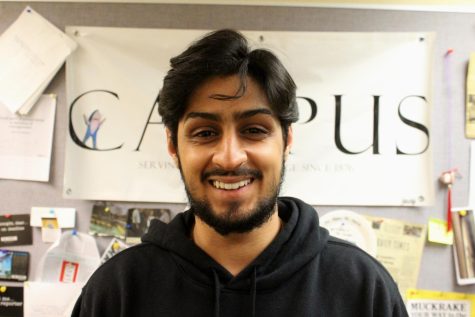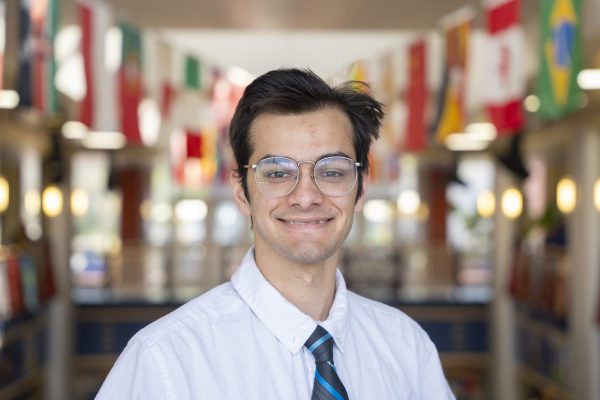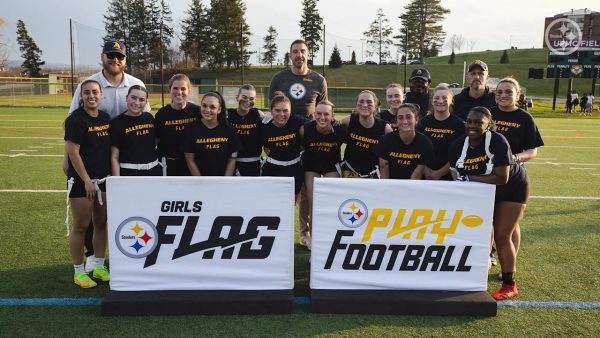URSCA offers on-campus summer research experiences
Program connects students and faculty with greater Meadville community
The front entrance of Carnegie Hall, the new home of the URSCA after it moved from what is now the Maytum Center for Student Success in Pelletier Library
Allegheny College offers students the opportunity to conduct student-faculty collaborative summer research via the Undergraduate Research, Scholarship and Creative Activities Program. The Allegheny College Research Seminar Series allows students to connect with faculty members and members of the local community and present their research to the wider Allegheny community and alumni at presentation seminars.
Director of URSCA and Professor of Psychology Aimee Knupsky explained the role of ACRoSS in the Allegheny College summer experience.
“In the summer, students have the opportunity to work with faculty members on research that they are conducting or develop their own idea to present at ACRoSS,” Knupsky said. “Students stay on campus anywhere between six and 10 weeks to perform this research for which they are stipended.”
ACRoSS works under the supervision of the URSCA office which is the key coordinator of undergraduate research at Allegheny College. Knupsky explained the role of URSCA.
“The URSCA office provides programming so that students can learn what others are researching on campus in the summer and so that they have an opportunity to share their work with the community, this is why (URSCA) created ACRoSS.”
Knupsky mentioned that ACRoSS serves as the platform on which students can present their research to the Allegheny and Meadville community and also attend other student’s presentations.
“ACRoSS took place every Tuesday this summer and we invited three students to present their work every week,” Knupsky said. “The nice thing about ACRoSS is that it is only students presenting their work and no one else.”
Knuspky stated that ACRoSS has historically taken place as a luncheon presentation but could not follow its traditional format due to COVID-19 restrictions.
“Unfortunately, ACRoSS sessions took place virtually this summer,” Knupsky said. “Usually we have these ACRoSS sessions in the Tillotson room (in the Tippie Alumni Center at Cochran Hall) and it’s jam packed. We’ve had up to a hundred people visiting in the past.”
Knupsky mentioned that students conducting summer research are funded and paid by the Provost office via several donors.
“The URSCA office works closely with the Provost’s office to connect students with faculty members and make projects possible by allocating funds and stipends to students,” Knupsky said. “We never want affordability to be a factor when a student is determining whether or not to consider summer research.”
URSCA works alongside the Gateway Network to collaborate with the local community in conducting research. Knupsky clarified the role of the Gateway Network in summer research on campus.
“(Director of the Gateway Network) Michael Willams, ’98, works to connect students, faculty members, and local community members for them to set up research projects,” Knupsky said. “This is important because Allegheny is really committed to playing its role in the local community and because Allegheny’s undergraduate is truly a great strength of the college.”
Williams explained that the Gateway Network provides community-focused projects for students throughout the year.
“During the summer we are able to provide students with a stipend to conduct in-depth research in collaboration with members of the Meadville community under the supervision of faculty members,” Williams said. “We also have projects, internships and research opportunities during the academic year that students can take part in for credits.”
Williams commented on the Gateway Network’s focus on five different areas when establishing research projects.
“We received funding from an anonymous source in Pittsburgh to focus, as a college, on creating partnerships with the community that assist the community in regard to economic development, environmental sustainability, educational initiatives, health and wellbeing, and arts and culture initiatives,” said Williams.
Williams explained the process through which the Gateway Network communicates with community members and the URSCA office to create partnerships between the students, the faculty and the community members.
“It is basically my job to regularly reach out to community members such as local business owners and farmers to understand their needs and communicate them with the URSCA office,” Williams said. “We are then able to find a student-faculty member match that collectively works with community members to produce different types of projects.”
Students working with the Gateway Network on research projects are able to produce different types of research. Williams mentioned.
“Some students were working to provide economic statistics and data for the Meadville region whereas others were working to create a roster with the Erie bird observatory,” said Williams.
Katherine Perez, ’24, conducted student-faculty research over the summer under the Gateway Network.
“This summer I worked with the Gateway Network, Professor (of Communication, Film and Theatre) Ishita Sinha Roy, and two other students on creating the course COMM 386,” Perez said. “We conducted interviews with 15 local businesses downtown to investigate what the terms ‘local’ and ‘community’ mean and how rural towns stay afloat.”
According to Perez, the focus of her research was how local businesses partner with the community, view their position within the community and how they brand themselves.
“Our research was used to design a class that Professor Sinha Roy will be teaching this fall,” Perez said. “Students will not only get to learn about the Meadville community but will also have a chance to collaborate with local businesses through this class. We even have a local business owner that will be guest-teaching a few of those classes.”

Hassan Javed is a junior from Lahore, Pakistan. He is majoring in Communication and Media Studies while minoring in Psychology. This is his third year...

Sami Mirza is a senior from many different places. He is majoring in International Studies with a focus on the Middle East and North Africa and minor in...









